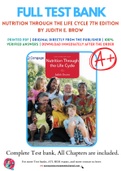PRINTED PDF | ORIGINAL DIRECTLY FROM THE PUBLISHER | 100%
VERIFIED ANSWERS | DOWNLOAD IMMEDIATELY AFTER THE ORDER
s t u v i a c o n t a c t + e x a m e h e l p @ g m a i l . c o mFor more Test banks, ATI, HESI exams, and more contact us here:
FULL TEST BANK
N u t r i t i o n T h r o u g h t h e L i f e C y c l e 7 t h E d i t i o n b y J u d i t h E . B r o w
Complete Test bank, All Chapters are included. Name: Class: Date: Chapter 1 - Nutrition Basics Copyright Cengage Learning. Powered by Cognero. Page 1 1. Cholesterol is an essential nutrient that must be obtained through one's diet. a. True b. False ANSWER: False 2. Lipids are soluble in water but are insoluble in fats. a. True b. False ANSWER: False 3. Generally, our bodies absorb a greater percentage of minerals than vitamins from dietary sources. a. True b. False ANSWER: False 4. Malnutrition can result from both inadequate and excessive levels of nutrient intake. a. True b. False ANSWER: True 5. Secondary malnutrition can be caused by both gastrointestinal tract bleeding and alcoholism. a. True b. False ANSWER: True 6. Individuals are 99.9 percent genetically identical, but the 0.1 percent difference in genetic codes makes everyone unique. a. True b. False ANSWER: True 7. Water is a nonessential nutrient. a. True b. False ANSWER: False 8. A product labeled "trans fat-free" could contain 0.4 g of trans fat. a. True b. False ANSWER: True 9. A dietary supplement can legally claim to treat, cure, or prevent a disease. a. True b. False ANSWER: False Name: Class: Date: Chapter 1 - Nutrition Basics Copyright Cengage Learning. Powered by Cognero. Page 2 10. Galactosemia is a disorder that interferes with the body's utilization of the sugar galactose found in lactose. a. True b. False ANSWER: True 11. A DASH eating plan is effective for reducing high blood pressure as well as the risk of some types of cancer, osteoporosis, and heart disease. a. True b. False ANSWER: True 12. What are the six categories of essential nutrients? a. carbohydrates, alcohol, fats, proteins, vitamins, and minerals b. carbohydrates, fiber, fats, proteins, vitamins, and minerals c. carbohydrates, proteins, fats, minerals, water, and vitamins d. carbohydrates, proteins, fiber, water, alcohol, and lipids ANSWER: c 13. Which of the following substances is an essential nutrient? a. fiber b. cholesterol c. linoleic acid d. vitamin D e. creatine ANSWER: c 14. A calorie is _____. a. a measure of the amount of energy transferred from food to the body b. a measure of the amount of energy inside the body's fat cells c. a component of fats that is soluble in water d. a chemical substance that activates enzymes e. a measure of the extent to which blood glucose levels are raised by consumption of food ANSWER: a 15. Which of the following is the primary function of ascorbic acid? a. It is required for the conversion of homocysteine to methionine. b. It participates in the regulation of gene expression. c. It is required for the transport and metabolism of fat and cholesterol. d. It acts as an antioxidant and is required for collagen synthesis. e. It is required for normal red blood cell formation. ANSWER: d 16. The Estimated Average Requirement (EAR) refers to _____. Name: Class: Date: Chapter 1 - Nutrition Basics Copyright Cengage Learning. Powered by Cognero. Page 3 a. an intake level estimated to meet the nutrient needs of 98% of healthy people b. an intake value estimated to meet the nutrient needs of half the healthy individuals in a group c. upper limits of a nutrient estimated to be compatible with health d. standard levels of daily nutrient intake e. an estimated level of nutrient intake for unhealthy people ANSWER: b 17. Complex carbohydrates include _____. a. glucose, glycogen, and most types of fiber b. glucose, sucrose, and fructose c. starches, glycogen, and most types of fiber d. starches, glucose, and sucrose e. starches, glycogen, and glucose ANSWER: c 18. Which two monosaccharides are found in sucrose (table sugar)? a. glucose and lactose b. glucose and glucose c. glucose and maltose d. glucose and fructose e. maltose and lactose ANSWER: d 19. Blood sugar is also known as _____, while fruit sugar is also known as _____. a. glucose; fructose b. glucose; lactose c. lactose; fructose d. maltose; lactose e. fructose; maltose ANSWER: a 20. Human digestive enzymes are unable to break down _____. a. sucrose b. glycogen c. alcohol sugars d. maltose e. fiber ANSWER: e 21. Carbohydrates that have a high glycemic index _____. a. help to build and maintain protein -based components in the body b. reduce elevated levels of blood cholesterol and triglycerides c. increase levels of HDL cholesterol




